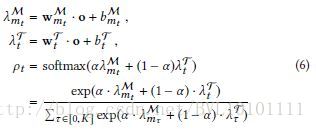</div>
<!--一个博主专栏付费入口-->
<!--一个博主专栏付费入口结束-->
<link rel="stylesheet" href="https://csdnimg.cn/release/phoenix/template/css/ck_htmledit_views-4a3473df85.css">
<div id="content_views" class="markdown_views prism-atom-one-dark">
<!-- flowchart 箭头图标 勿删 -->
<svg xmlns="http://www.w3.org/2000/svg" style="display: none;">
<path stroke-linecap="round" d="M5,0 0,2.5 5,5z" id="raphael-marker-block" style="-webkit-tap-highlight-color: rgba(0, 0, 0, 0);"></path>
</svg>
<p>最近刷了一些attention相关的paper(照着<a href="https://zhuanlan.zhihu.com/p/29918534" rel="nofollow" target="_blank">here</a>的列表+自己搜的paper),网上相关的资料也有很多,在此只讲一讲自己对于attention的理解,力求做到简洁明了。</p>
一.attention 的本质
attention其实就是一个加权求和。
attention处理的问题,往往面临的是这样一个场景:
你有kk维)。
solution:
1.一个最简单粗暴的办法就是这kk,显然不够合理。
2.较为合理的办法就是,加权平均,即(αiαi
而attention所做的事情就是如何将αiαi合理的算出来。
二.attention 的设计
如何计算得到αiαi,一般分两个步骤:
step 1: 设计一个打分函数ff值越大。
step 2:对所得到的kk
那么如何设计step 1中的打分函数ff呢,在论文”Dynamic Attention Deep Model for Article Recommendation by Learning Human Editors’Demonstration”中的Attention Mechanism章节给了较为全面的概括。大体分为三类:
1.Location-based Attention
2.General Attention
3.Concatenation-based Attention
其中General Attention并不常见,(可能笔者读的paper不够多,目前还没有遇到过)因此在这里不做介绍。接下来详细介绍下Location-based Attention和Concatenation-based Attention的设计。
2.1 Location-based Attention
应用场景, 比如 对于一个问题‘Where is the football?’, ‘where’ 和‘football’ 在句子中起着总结性的作用。而这种attention只和句子中每个词自身相关。
Location-based的意思就是,这里的attention没有其他额外所关注的对象,即attention的向量就是hihi,这里的激活函数activation,常见的有三种:1)tahn,2)relu,3)y=x(即没有激活函数)
具体我们来举几个例子,可能具体实现上,有略微区别,不过都大同小异:
Example 1:A Context-aware Attention Network for Interactive Interactive Question Answering_KDD2017
这篇文章涉及多个attention,这里只举相关的几个例子:

可以看到, gqjgjq再进行下一步操作。
Example 2:Dynamic Attention Deep Model for Article Recommendation by Learning Human Editors’ Demonstration_KDD2017
这里用了两种不同的attention,通过权重αα)

2.1 Concatenation-based Attention
Concatenation-based意思就是,这里的attention是指要关注其他对象。
我们用htht可以是用cnn提取得到的图片信息,用rnn提取得到的句子信息等等)。
需要注意的是这里的htht可以是恒定不变的一个向量(比如整个句子的向量表达),也可以是随着时序不断变化的向量(比如句子中的单词的向量表达,不同时刻,面对的是句子中不同的单词),具体问题,具体设计
而ff。
函数的描述的意思就是,希望通过W1,W2W1,W2计算score。
具体我们来举几个例子,可能具体实现上,有略微区别,不过都大同小异:
Example 1:Attentive Collaborative Filtering Multimedia Recommendation with Item- and Component-Level Attention_sigir17
这篇论文讲了多层的attention
其中一层是:


这里 uiui 。可以说是,想加什么attention,就直接把对应向量往公式里一加,即可。
另一层是:


与第一层的attention类似,不多讲。
Example 3:Dipole Diagnosis Prediction in Healthcare via Attention-based Bidirectional Recurrent Neural Network_2017KDD
在这篇论文中,将上下文的文本信息作为attention,即公式(7)中的cici。


Example 4:Enhancing Recurrent Neural Networks with Positional Attention for Question Answering_SIGIR2017
通过题目 Positional Attention也大致可以猜到,作者应该通过其他方式得到了一个position的表达向量pjpj,将其作为attention,具体公式如下:


Example 5:Learning to Generate Rock Descriptions from Multivariate Well Logs with Hierarchical Attention_2017KDD
和前面类似,不多讲,直接上公式:



Example 6:Reasoning about entailment with neural attention_ICLR2016
也不多讲,直接上公式
看到这里相信大家对于attention有了较为直观的感觉,其实套路都差不太多,看各家paper给出的公式也都差不多,具体是结合问题,怎么去设计这个attention向量,怎么去说故事罢了。
三.attention 的扩展 (多层attention,常见的是2层)
举个简单的例子,一个文档由k2k2大小不一)个word组成。
第一层:word-level的attention
对于每个sentence有k1k1,然后,得到这些,具体任务具体分析。
这里举几个例子(不具体展开讲公式),比如:
Example 1:A Context-aware Attention Network for Interactive Interactive Question Answering_KDD2017
输入一篇文档和问题,输出回答
第一层attention:
先用location attention+ mlp对问题embedding成一个向量u
用Concatenation-based Attention(前一个句子和当前句子concatenation)+与u的相似度进行计算attention score建模,得到每个句子的embedding
第二层attention
以句子的embedding的粒度,对整个文档进行attention(利用与u的相似度进行计算attention score)
Example 2:Leveraging Contextual Sentence Relations for Extractive Summarization Using a Neural Attention Model_SIGIR2017
输入一篇文档,输出文档的summarize
第一层attention
(Location-based Attention) ,word-level,来生成每个句子的vector
第二层attention
利用第一层句子的vector,将当前句子作为中心,前n个句子和后n个句子组成的2n+1个句子的序列,作为RNN输入,将中心句子作为attention,来embedding上下文,然后通过上下文,对这个中心句子进行打分,作为句子对于整个文本的重要性的依据。
Example 3: Learning to Generate Rock Descriptions from Multivariate Well Logs with Hierarchical Attention_2017KDD
输入矿井的特征,有n个特征,每个特征是一个时间序列,表示不同深度的该特征。
第一层attention(location attention)
因为每一个特征都是一个时间序列,因此可以用rnn+attention对其进行embedding,成一个vector。生成了n个vector
第二层attention
和其他attention不同的是,世界对这n个向量进行(location attention)算score,因此这里的attention和rnn没有什么关系。
Example 4:Attentive Collaborative Filtering Multimedia Recommendation with Item- and Component-Level Attention_sigir17
用了两层attention。
第一层attention
每个item有多种feature,在feature-level的attention上,用user vector去做。然后得到每个item的vector。
第二层attention
结合了好几个feature进行打分,最后得到一个user feature的vector。与最原始的user vector结合起来得到了最后的user vector,然后与item做内积,判断相似性与喜好。
四.总结
目前来看,attention的套路还是很固定的,主要的关键点是如何结合具体问题,设计出你所要关心的attention,即htht 加入到model中去,作为计算score的依据。








 本文深入浅出地解析了Attention机制的本质,介绍了Location-based Attention和Concatenation-based Attention的设计,并探讨了多层Attention的应用,旨在帮助读者理解如何在具体问题中设计和应用Attention。
本文深入浅出地解析了Attention机制的本质,介绍了Location-based Attention和Concatenation-based Attention的设计,并探讨了多层Attention的应用,旨在帮助读者理解如何在具体问题中设计和应用Attention。

















 435
435

 被折叠的 条评论
为什么被折叠?
被折叠的 条评论
为什么被折叠?








